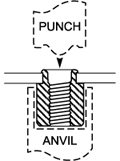Illustration of the Swaging Process
Follow these instructions for a superior installation of both plain swage standoffs and knurled swage standoffs. Knurled swage standoffs offer more holding power than plain standoffs, and eliminate electrical connection breaks due to loosening and spinning of the standoff because of high torque stresses.
Hole Specifications
Plain Swage Standoff – A plain swage standoff (no knurl) requires a STRAIGHT HOLE. The hole diameter in the board or panel is the same as the shank (or shoulder) diameter of the standoff with a tolerance of +.003″/-.000″ (+.076 mm/-.000 mm).
Partial Knurl or Full Knurl Swage Standoff – A partial knurl or full knurl swage standoff requires a STRAIGHT HOLE in a printed circuit board. The hole diameter in the board is .010″ to .012″ smaller than the shank (or shoulder) diameter of the standoff with a tolerance of +.005″/-.000″ (+.13 mm/-.000 mm).
Methods of Installation
Swage

While some dimensions of the punch and anvil change with the size of the swage standoffs, the following dimensions remain constant:
- The punch is 2.5″ in overall length and .5″ OD
- The anvil is 1″ in overall length and .5″ OD with a 1/2-24 external thread
- Punch and anvil part numbers for swaging are listed on the individual pages of plain and partial knurl swage standoffs
Flare
 Flare tool is not supplied
Flare tool is not supplied- Flare angle should be same as countersink angle
- For flush flaring into countersunk hole use shank length .020″ shorter than board thickness
How Can We Help You? Request Samples Or A Quote
China Electronic Hardware is your one-stop reliable source. If you need additional information on our products, service, samples or anything else, give us a call to speak with a representative. You can also request quotes or samples online to skip the phone call for fast delivery.
















































































